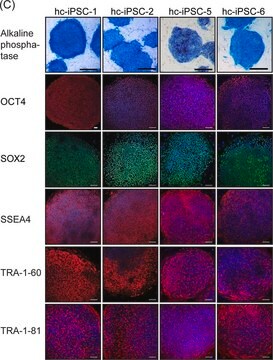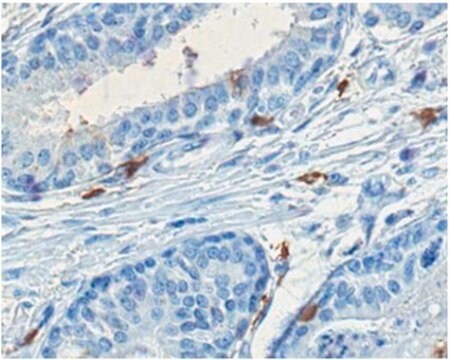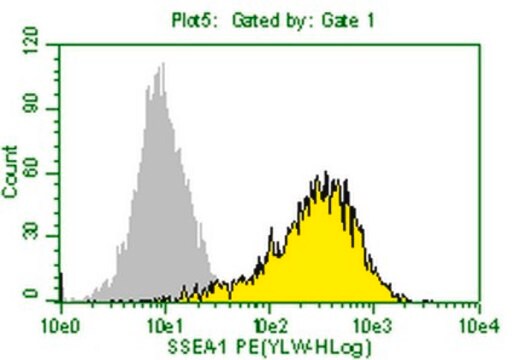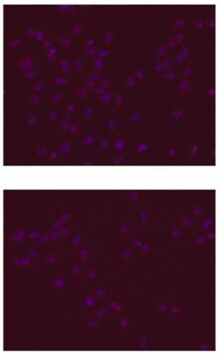추천 제품
생물학적 소스
rat
Quality Level
항체 형태
purified antibody
항체 생산 유형
primary antibodies
클론
MC-631, monoclonal
종 반응성
human
종 반응성(상동성에 의해 예측)
mouse
기술
flow cytometry: suitable
immunocytochemistry: suitable
immunofluorescence: suitable
immunohistochemistry: suitable
동형
IgMκ
배송 상태
wet ice
타겟 번역 후 변형
unmodified
일반 설명
Stage-specific embryonic antigen 3 (SSEA-3) is a glycosphingolipid composed of five carbohydrate units connected to a sphingolipid. Sphingolipids are key players in cell signaling and the SSEA-3 is a well known marker of stem cells (ESCs, MSCs, iPSCs, CSCs) differentiation, where SSEA-3 rapidly disappears when the cells start to differentiate.
특이성
Reacts with the Stage-specific embryonic antigen-3 (SSEA-3) that is expressed on the surface of human teratocarcinoma stem cells (EC), human embryonic germ cells (EG) and human embryonic stem cells (ES). No immunoreactivity is evident with undifferentiated murine EC, ES and EG cells. Expression of SSEA-3 is down regulated following differentiation of human EC cells. In contrast, the differentiation of murine EC and ES cells may be accompanied by an increase in SSEA-3 expression.
면역원
4-8 cell stage mouse embryos.
애플리케이션
Immunocytochemistry Analysis: 10µg/mL from a representative lot detected Stage-Specific Embryonic Antigen-3 in H9 cells.
Immunocytochemistry Analysis: A representative lot detected SSEA-3 immunoreactivity among T
cell-derived iPSCs (TiPSCs) by fluorescent immunocytochemistry (Kishino, Y., et al. (2014). PLoS One. 9(5):e97397).
Immunocytochemistry Analysis: A representative lot detected the presence of SSEA-3-positive cancer stem cells (CSCs) among cultured HCT116 colorectal cancer (CRC) cells by fluorescent immunocytochemistry (Suzuki, Y., et al. (2013). Int. J. Oncol. 42(1):161-167).
Immunocytochemistry Analysis: A representative lot detected SSEA-3 immunoreactivity among induced pluripotent stem (iPS) cells from human molars-derived mesenchymal stromal cells (MSCs) by fluorescent immunocytochemistry (Oda, Y., et al. (2010). J. Biol. Chem. 285(38):29270-29278).
Flow Cytometry Analysis: A representative lot detected the presence of SSEA-3-positive cancer stem cells (CSCs) in five cultured colorectal cancer (CRC) cell lines, HCT116, Caco-2, DLD-1, HT-29, and SW480 (Suzuki, Y., et al. (2013). Int. J. Oncol. 42(1):161-167).
Immunofluorescence Analysis: A representative lot detected a mall number of SSEA-3-positive stromal cells in normal colorectal epithelia and SSEA-3-positive cancers in colorectal adenocarcinomas by fluorescent immunohistochemistry using frozen tissue sections (Suzuki, Y., et al. (2013). Int. J. Oncol. 42(1):161-167).
Immunocytochemistry Analysis: A representative lot detected SSEA-3 immunoreactivity among T
cell-derived iPSCs (TiPSCs) by fluorescent immunocytochemistry (Kishino, Y., et al. (2014). PLoS One. 9(5):e97397).
Immunocytochemistry Analysis: A representative lot detected the presence of SSEA-3-positive cancer stem cells (CSCs) among cultured HCT116 colorectal cancer (CRC) cells by fluorescent immunocytochemistry (Suzuki, Y., et al. (2013). Int. J. Oncol. 42(1):161-167).
Immunocytochemistry Analysis: A representative lot detected SSEA-3 immunoreactivity among induced pluripotent stem (iPS) cells from human molars-derived mesenchymal stromal cells (MSCs) by fluorescent immunocytochemistry (Oda, Y., et al. (2010). J. Biol. Chem. 285(38):29270-29278).
Flow Cytometry Analysis: A representative lot detected the presence of SSEA-3-positive cancer stem cells (CSCs) in five cultured colorectal cancer (CRC) cell lines, HCT116, Caco-2, DLD-1, HT-29, and SW480 (Suzuki, Y., et al. (2013). Int. J. Oncol. 42(1):161-167).
Immunofluorescence Analysis: A representative lot detected a mall number of SSEA-3-positive stromal cells in normal colorectal epithelia and SSEA-3-positive cancers in colorectal adenocarcinomas by fluorescent immunohistochemistry using frozen tissue sections (Suzuki, Y., et al. (2013). Int. J. Oncol. 42(1):161-167).
Research Category
Stem Cell Research
Stem Cell Research
Research Sub Category
Cell Cycle, DNA Replication & Repair
Cell Cycle, DNA Replication & Repair
This Anti-Stage-Specific Embryonic Antigen-3 Antibody, clone MC-631 is validated for use in Flow Cytometry, Immunocytochemistry, Immunofluorescence and Immunohistochemistry for the detection of Stage-Specific Embryonic Antigen-3.
품질
Evaluated by Flow Cytometry in H9 cells.
Flow Cytometry Analysis: 1.0 µg of this antibody detected Stage-Specific Embryonic Antigen-3 in H9 cells.
Flow Cytometry Analysis: 1.0 µg of this antibody detected Stage-Specific Embryonic Antigen-3 in H9 cells.
결합
Replaces: MAB4303
물리적 형태
Format: Purified
Purified rat monoclonal IgMκ antibody in PBS with 0.05% sodium azide.
저장 및 안정성
Stable for 1 year at 2-8°C from date of receipt.
기타 정보
Concentration: Please refer to lot specific datasheet.
면책조항
Unless otherwise stated in our catalog or other company documentation accompanying the product(s), our products are intended for research use only and are not to be used for any other purpose, which includes but is not limited to, unauthorized commercial uses, in vitro diagnostic uses, ex vivo or in vivo therapeutic uses or any type of consumption or application to humans or animals.
적합한 제품을 찾을 수 없으신가요?
당사의 제품 선택기 도구.을(를) 시도해 보세요.
Storage Class Code
10 - Combustible liquids
WGK
WGK 2
Flash Point (°F)
Not applicable
Flash Point (°C)
Not applicable
시험 성적서(COA)
제품의 로트/배치 번호를 입력하여 시험 성적서(COA)을 검색하십시오. 로트 및 배치 번호는 제품 라벨에 있는 ‘로트’ 또는 ‘배치’라는 용어 뒤에서 찾을 수 있습니다.
Yozo Suzuki et al.
International journal of oncology, 42(1), 161-167 (2012-11-24)
Findings from studies on stem cells have been applied to cancer stem cell (CSC) research, but little is known about the relationship between ES cell-related cell surface markers and CSCs. In this study, we focused on stage-specific embryonic antigen 3
Yasuaki Oda et al.
The Journal of biological chemistry, 285(38), 29270-29278 (2010-07-03)
The expression of four transcription factors (OCT3/4, SOX2, KLF4, and MYC) can reprogram mouse as well as human somatic cells to induced pluripotent stem (iPS) cells. We generated iPS cells from mesenchymal stromal cells (MSCs) derived from human third molars
Yoshikazu Kishino et al.
PloS one, 9(5), e97397-e97397 (2014-05-16)
Recently, induced pluripotent stem cells (iPSCs) were established as promising cell sources for revolutionary regenerative therapies. The initial culture system used for iPSC generation needed fetal calf serum in the culture medium and mouse embryonic fibroblast as a feeder layer
자사의 과학자팀은 생명 과학, 재료 과학, 화학 합성, 크로마토그래피, 분석 및 기타 많은 영역을 포함한 모든 과학 분야에 경험이 있습니다..
고객지원팀으로 연락바랍니다.






